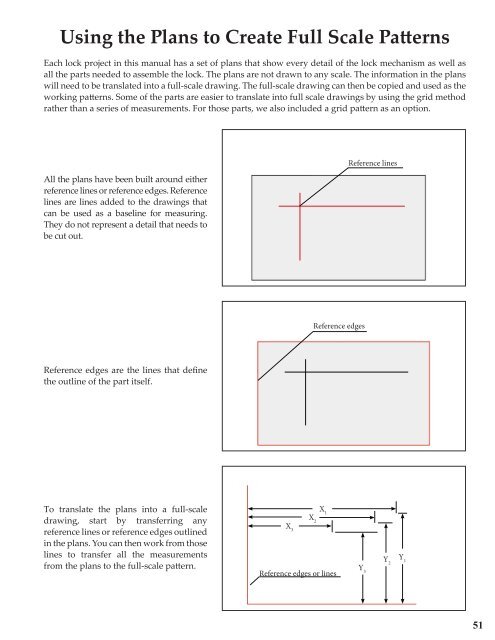The New Spruce Forge Manual of Locksmithing: A Blacksmith’s Guide to Simple Lock Mechanisms
The New Spruce Forge Manual of Locksmithing: a Blacksmith’s Guide to Simple Lock Mechanisms is a totally revised and expanded version of the original work from 1999. This new hardcover edition, at 304 pages and with more than 800 color photos and illustrations, is more than double the size of the original manual. It is divided into two distinct sections: Technical Information - This section is a reference manual in itself that covers the specific tools and techniques needed to build all the parts for each lock, as well as providing the information needed to understand the assembly instructions outlined in the second section. The Locks: Patterns & Instructions - This section provides the plans and detailed instructions for each of the 14 lock projects in this new edition. The clear assembly instructions describe when and how to use the technical information provided in section one. The authors have maintained their original trademark style that relies on well-illustrated step-by-step instructions that guide you through the whole lock-making process. They have also kept their low-tech approach that demonstrates how to go about creating good work using only a handful of simple tools. Making blacksmith locks is an age-old skill the authors of this manual are helping to preserve by passing on their knowledge to this book’s readers. The New Spruce Forge Manual of Locksmithing is also an excellent introduction to benchwork, which is a useful skill for any blacksmith to acquire. This manual will become a valuable, trusted and often referred to sourcebook in your blacksmithing library. Hardcover, 304 pages, more than 800 photos and illustrations.
The New Spruce Forge Manual of Locksmithing: a Blacksmith’s Guide to Simple Lock Mechanisms is a totally revised and expanded version of the original work from 1999. This new hardcover edition, at 304 pages and with more than 800 color photos and illustrations, is more than double the size of the original manual.
It is divided into two distinct sections:
Technical Information - This section is a reference manual in itself that covers the specific tools and techniques needed to build all the parts for each lock, as well as providing the information needed to understand the assembly instructions outlined in the second section.
The Locks: Patterns & Instructions - This section provides the plans and detailed instructions for each of the 14 lock projects in this new edition. The clear assembly instructions describe when and how to use the technical information provided in section one.
The authors have maintained their original trademark style that relies on well-illustrated step-by-step instructions that guide you through the whole lock-making process. They have also kept their low-tech approach that demonstrates how to go about creating good work using only a handful of simple tools.
Making blacksmith locks is an age-old skill the authors of this manual are helping to preserve by passing on their knowledge to this book’s readers. The New Spruce Forge Manual of Locksmithing is also an excellent introduction to benchwork, which is a useful skill for any blacksmith to acquire. This manual will become a valuable, trusted and often referred to sourcebook in your blacksmithing library.
Hardcover, 304 pages, more than 800 photos and illustrations.
Create successful ePaper yourself
Turn your PDF publications into a flip-book with our unique Google optimized e-Paper software.
Using the Plans <strong>to</strong> Create Full Scale Patterns<br />
Each lock project in this manual has a set <strong>of</strong> plans that show every detail <strong>of</strong> the lock mechanism as well as<br />
all the parts needed <strong>to</strong> assemble the lock. <strong>The</strong> plans are not drawn <strong>to</strong> any scale. <strong>The</strong> information in the plans<br />
will need <strong>to</strong> be translated in<strong>to</strong> a full-scale drawing. <strong>The</strong> full-scale drawing can then be copied and used as the<br />
working patterns. Some <strong>of</strong> the parts are easier <strong>to</strong> translate in<strong>to</strong> full scale drawings by using the grid method<br />
rather than a series <strong>of</strong> measurements. For those parts, we also included a grid pattern as an option.<br />
All the plans have been built around either<br />
reference lines or reference edges. Reference<br />
lines are lines added <strong>to</strong> the drawings that<br />
can be used as a baseline for measuring.<br />
<strong>The</strong>y do not represent a detail that needs <strong>to</strong><br />
be cut out.<br />
Reference lines<br />
Reference edges<br />
Reference edges are the lines that define<br />
the outline <strong>of</strong> the part itself.<br />
To translate the plans in<strong>to</strong> a full-scale<br />
drawing, start by transferring any<br />
reference lines or reference edges outlined<br />
in the plans. You can then work from those<br />
lines <strong>to</strong> transfer all the measurements<br />
from the plans <strong>to</strong> the full-scale pattern.<br />
X 2<br />
X 1<br />
X 3<br />
Y 1 Y 2<br />
Y 3<br />
Reference edges or lines<br />
51










